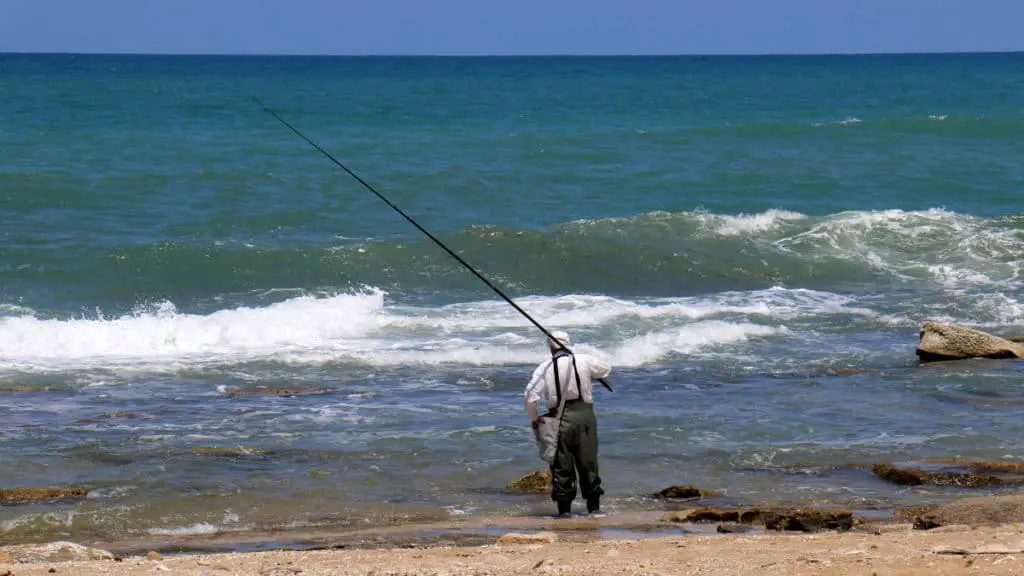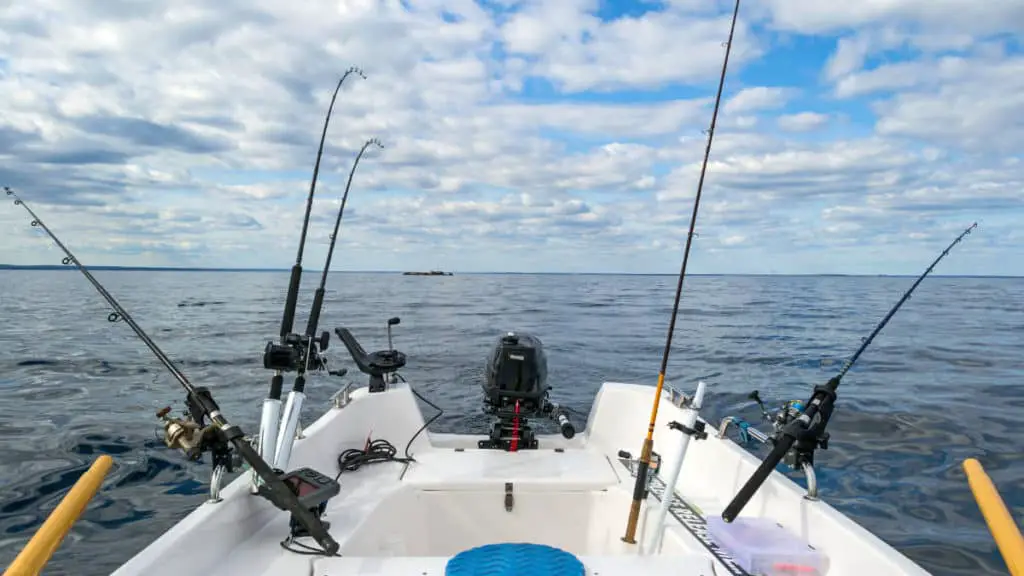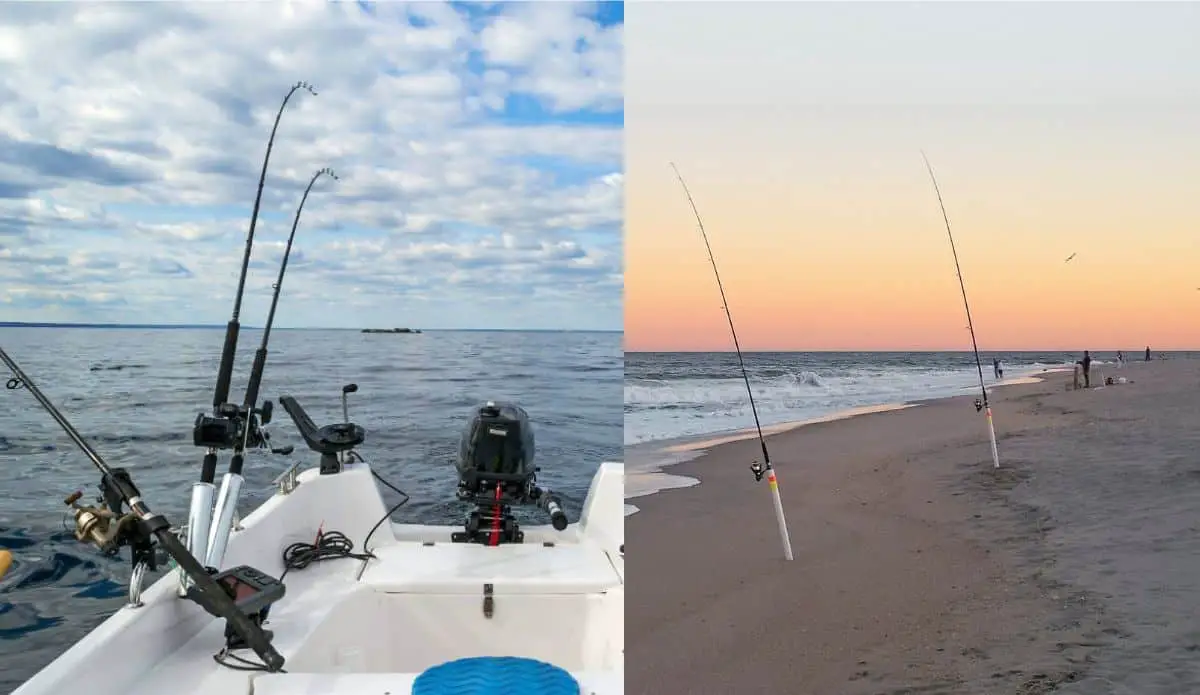Trolling, surf fishing – these are just a few of the ways that a fisherman can get the bait to his audience. I’m no fishing expert, but I have put a bit of time and effort into investigating the different fishing techniques, and I feel that you could gain a lot – whether a seasoned pro fisherman or a beginner to the sport – by perfecting a variety of techniques along the way.
Two fishing styles have that have been of interest to me are trolling and surf fishing.
What is the difference between trolling and surf fishing? The main difference between trolling and surf fishing is how the lure or bait is used. Surf fishing is done from the shore where the fishing line is baited, with bait or a lure, and cast into the shallow water. Trolling is done by dragging fishing lines, baited with bait or lures, behind a boat or from the side of a jetty.
I have found that whether you embark on a trolling or surf fishing expedition is really dependent on several factors. Find out what these factors are, discover more on the major differences between surf fishing & trolling, learn how to choose the right fishing technique for your situation, and learn a few tips for both surf fishing and trolling below.
The Main Differences Between Trolling & Surf Fishing
If you fish often, you are probably already aware that these fishing styles are worlds apart. Nothing can quite beat the bliss of a good catch though.
So being able to read the weather and have access to knowledge on a variety of fishing styles can really help you to be versatile enough to make decisions on the day (regarding where to go and what type of fishing to do) that ensure the best possible catch at the time.
Surf fishing and trolling are both popular styles of fishing – at least that’s what I have found. When it comes to the differences, they are fairly obvious. For starters, you aren’t exactly going to be trolling from the shore in shallow waters.
If you are fishing from the beach, surf fishing is probably the best answer.
Trolling is better suited to deeper waters where you can use a boat. Lines are tailed from behind the boat, enticing a good catch. Surf fishing involves casting and reeling the line back in as needed.
Check Out The Table Below to See a Few of The Differences Between Surf Fishing and Trolling.
| Surf Fishing | Trolling Fishing |
| Long casting rods are used to cast far out from the shore. | Boards with several fishing lines are used instead of rods. |
| You are within casting distance of the shore – no deeper than wading depth. | This can be done in some shallow waters but is better suited to water a little deeper than the shore waves. |
| Enjoyed from various spots such as mangroves, beaches, piers, & rocky shorelines. | Can be done anywhere up to 30 to 100 miles off coast or in large bodies of water. |
| You can use either light tackle or heavy tackle for surf casting. It also required waders to avoid getting wet. | Boats, heavier tackle, electronic equipment is often used. |
| Hands-on techniques are required and you need a keen understanding of the shore, water, and the areas you are fishing in. | Less hands-on fishing techniques are required and as long as the water is deep enough for your boat, trolling requires minimal effort. |
What Should I Choose? Trolling or Surf Fishing?
When is trolling surf fishing best? What factors will influence your choice? The fishing technique you use will depend on the type of fishing trip you are planning and what sort of fish you want to catch.
Where you are planning to fish and what equipment you have will also play a role in whether you go trolling or surf fishing.
Surf fishing![]() is most typically done in saltwater from the shore or by wading into shallow water from the beach. Trolling requires a boat in most instances and can be done on both salt and freshwater.
is most typically done in saltwater from the shore or by wading into shallow water from the beach. Trolling requires a boat in most instances and can be done on both salt and freshwater.
Are you hoping to spend the day on the beach while fishing? Surf fishing is the obvious choice. Want to go a bit further out or fish on the local dam? Trolling is the best option.
I would suggest trying out both types of fishing techniques to decide which is more suited to your personal fishing style and preferences.
Perhaps a day on the beach is not for you…or maybe going out on a boat for hours isn’t your cup of tea. You won’t know until you try both out.
Tips for Surf Fishing

If you have gone surf fishing before, you probably know the basics. However, there are a few things that you can do to improve your fishing experience.
Of course, if you are anything like me, you want the best possible catch when you head to the beach for some surf fishing.
Below are some tips that I have used myself to get the most out of surf fishing trip:
Investigate Popular Surf Fishing Beaches And Get to Know Them Better.
Chances are that you are going to return to the same beaches time and again for a bit of fishing, so it’s best that you familiarize yourself with the general fishing conditions.
Plan to walk the beach at low tide so that you can make a note of the banks, gullies, obstructions, sea-bed changes, and hidey-holes for fish.
This will help you to cast more strategically at high tide, instead of just casting out as far as you can and hoping for the best.
If you want to learn more about how to read the beach when surf fishing, read this article.![]()
Timing is Everything – Fish at The Best Times of The Day.
The time of day![]() that you go surf fishing is quite important if you want a good catch.
that you go surf fishing is quite important if you want a good catch.
Why go out if you know you aren’t going to get a bite? You wouldn’t waste your time if you knew that your chances were greatly reduced at certain times, would you?
You probably already know that fish don’t like to eat in bright light conditions. If you are lucky enough to plan a trip when high tide coincides with dusk or dawn, then your surf fishing efforts are bound to be highly successful.
If you can’t plan your fishing trips at such times or only have a couple of hours to dedicate to fishing and still want a good catch, it’s best to go surf fishing 2 hours before high tide and 2 hours after high tide.
Tide schedules are usually published daily, but you can also download a tide and weather app to your smartphone to keep track of the best fishing times.
Avoid Spool Slipping by Making Yourself a “Thumby.”
Bait cast reels are infamous for slipping under a fisherman’s thumb. This can be particularly annoying and counterproductive in wet fishing conditions.
You can actually avoid this by cutting a finger off an old rubber glove and wearing it on your thumb when fishing.
Translate the Meaning of the Surf Conditions so You Can Cast Strategically.
If you look out in the sea and simply see a body of water, you are doing it wrong. Spend some time observing the surf and relating what you see to what you recognized when you walked the beach at low tide.
Where water swirls, there is probably a rock or obstruction. A flat sea usually means that the water is quite deep (and that means there’s fish there).
Look For Strong Winds And Low Atmospheric Pressure For Day Time Surf Fishing.
The weather conditions play a role in how productive fish activity is. Strong winds and low atmospheric pressure are best for surf fishing during the day for the simple reason that fish are usually found in much deeper waters when offshore winds are around.
These winds and high atmospheric pressures create smooth, clear, waters which can spook fish trying not to get eaten or caught! Low winds and high atmospheric pressure![]() are more suitable conditions for night time surf fishing.
are more suitable conditions for night time surf fishing.
Always Use Shock Leaders to Minimize The Risk of a Line Snapping.
Crack-off (when you have a poor cast that results in the line snapping) can result in the loss of fishing gear. This can be frustrating for the fisherman as well as pose certain risks for other people on the beach.
Shock leaders can reduce the occurrence or risk of crack-off. When choosing shock leaders, pay attention to the weight of the lead. A general rule of thumb is that the shock leader must be 10x the weight of the lead that you use.
Tips for Trolling Fishing

Trolling is a type of fishing that can be considered quite advanced even though once you’ve got out on the water, it requires minimal effort. That being said, I have found that you can’t just hop in a boat and somehow get it right.
You at least need to know what you are doing and have the right fishing gear to support you. There is a lot of gear, equipment, and various techniques that you can learn if you want to make the most of your trolling trip.
That being said, you can still enjoy a good trolling fishing trip without spending a lot of money. In many instances, you can find trolling gear for sale at a low price that is just as good as the more pricey brands.
Don’t feel pressured to get caught up in brands and “best buys” when you are just starting out. Below are a few tips that I feel will improve your chances of an excellent catch while trolling.
Invest in Decent Fishing Gear & Equipment Designed Specifically for Trolling.
It is essential to have the recommended gear when trolling. Again, I would like to reiterate that expensive equipment doesn’t automatically make it decent.
You should at the very least have the following items in your trolling gear collections: long trolling rods![]() of between 7 and 9 feet, baitcasting reels with line counters, and planer boards.
of between 7 and 9 feet, baitcasting reels with line counters, and planer boards.
Use Electronic Fishing Equipment to Help With Your Strategy.
For many people, using electronics is like cheating, but is it really? It doesn’t have to be. Your fishing trip can still be somewhat of a hunt if you simply use it to locate fish groups and check water depths. Having this knowledge before trolling can help to ensure a better catch.
Add Action to Your Bait to Get The Attention of Fish.
Fish can follow bait or a lure a lot longer than you think. To encourage your catch to bite, you need to add a bit of action to your bait. You can do this by turning the boat and changing speed.
The more action your bait presents, the more incentive fish will have to bite.
Go Easy on The Line Quantities to Avoid Snagging and Tangling.
When you first start out with trolling, it can be tough to troll through changing water conditions and catch fish effectively. The more lines you have, the more risk there is of them tangling and slowing you down.
Working with just 3 lines is a great starting point. As you become more experienced and comfortable with trolling techniques, you can increase your boards and lines.
Some professionals work their way up to trolling with multiple boards and lines – even up to 10!
Keep Your Boat Moving to Avoid Snagging of Your Lines.
Stopping the boat when you have a hook may just result in snagging. This is a mistake that many first-time trolling fishers make. When you have a hook, fight the fish while the boat is still moving.
Even if you get a snag somewhere along the way, untangle the line while still moving forward. It’s much easier to do this than trying to untangle or unsnag everything while the boat is in neutral.
Last Word
I would definitely say that a fisherman’s personal preferences will determine whether he is a trolling or surf fishing type of angler. Understanding the difference between these two fishing techniques/styles is important if you want to embark on fishing trips that you actually enjoy (and get a great catch).

